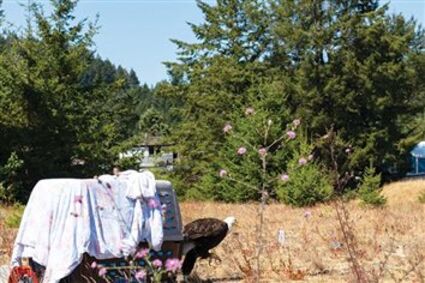Rehabbed bald eagle released near McGlinn Island
August 2, 2022

EAGLE FOUND HIS WINGS- A lead-poisoned female bald eagle was found in a rock jetty between McGlinn and Goat islands. After 42 days in rehabilitations with PAWS, the eagle was released near McGlinn Island July 28. Rescuer Ted Edge, Jr, photo page 9. -Photo by Marissa Conklin
She’s a free bird again.
And healthy, too.
A five-year-old female bald eagle held in captivity for six weeks while being successfully treated for lead toxicity was released back into the wild near McGlinn Island south of La Conner July 28.
The staff at PAWS (Progressive Animal Welfare Society) in Snohomish County got the lead out of the eagle – it was weakened to the point of having difficulty standing and not being able to fly – with a medical regimen specifically designed to address heavy metal poisoning.
“The eagle received chelation therapy,” PAWS naturalist Jeff Brown told the Weekly News. “This consists of dosing a chemical that will bind to the lead and later allow the body to excrete the toxin.”
The white-headed raptor was rescued by Swinomish crabber Ted Edge, Jr. along the rock jetty between McGlinn and Goat islands in June.
“It was an amazing experience,” said 30-year-old Edge. “I thought I was seeing a seagull bathing on the jetty. When I got closer, I could see it was an eagle that was distressed and looking for help.”
The eagle painstakingly swam toward the boat Edge was working, “Baby Girl,” owned by Donald Damien, and operated by Edge’s sister, Heather.
“I used a crab buoy hook to help it onto the vessel,” he said.
Edge then found a burlap sack with which to help dry the cold, soaked bird.
“I’ve never seen an animal shake so much,” he said.
While modest about his role in the rescue, Edge said he understood the importance of what he did because it was in keeping with traditional tribal values about reverence for life he had been taught as a youth.
“It’s an uplifting moment right now,” he said. “It’s something that is life-changing, that can change your point of view about life. That’s how I feel. The main thing is keeping the good teachings going.”
Once ashore, Edge drove the eagle to the Washington Department of Fish and Wildlife office on Sherman Street near the public boat launch. There, he transferred the bird to WDFW Officer John Ludwig, who in turn transported it to a pet emergency center on Avon-Allen Road.
The eagle was ultimately sent for therapy at the PAWS Lynnwood campus, which is equipped with enclosures to accommodate the rehabilitation of wildlife species.
After 42 days, the eagle was ready to return home. Eagles, loons and swans are especially susceptible to lead poisoning, said Brown.

Still, most of the eagles PAWS treats are victims of collisions with vehicles.
“We get a couple eagles a year with lead toxicity,” Brown said. “The common source of lead poisoning in eagles is from what they eat. Eagles might consume weak waterfowl that previously ingested lead fishing gear or old lead shot in our wetlands, or from scavenging remains of hunted animals.”
Brown said lead is easily absorbed in the body once it is in the digestive system. Lead toxicity causes weakness, impaired motor function, seizures, diarrhea and in some cases, death.
“This bird,” he stressed, “had very high levels of lead in its system. This explains why it was found weak in Skagit Bay.”
The eagle was released in an open field across McGlinn Island Drive from Latitude Marine Services, about “one minute in flight time from where it was picked up,” said Ludwig.
“A key for PAWS,” Brown said, “is to do the release in the vicinity of where it was rescued.”
Weather dictated the timing of the release, which took place just after 12 p.m., said PAWS Director of Communications Mick Szydlowski.
Edge’s mom, Laurentia, and other family members were among those who witnessed the release.
The eagle remained inside the carrier briefly after a covering was lifted and the door opened. That is not unusual, according to Brown.
“It’s been sitting in a box in the back of a truck hearing highway noise,” he said. “It’s going to be out of its normal head space for a bit.”
Eventually, the eagle emerged. It looked around, performed a bodily function, and then took flight to a perch in a nearby tree.
Mission accomplished.
“This,” said Szydlowski, as the eagle peered down from its new safe haven, “was an exciting day for us.”




Reader Comments(0)